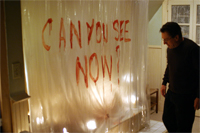The psychology of a boring movie
'Hide and Seek' fails in bid to show danger, suspense of childhood game
By CHUUN SUN
John Polson’s “Hide and Seek” tries to capture the innocence and danger of playing hide and seek — a childhood favorite for many. But what the film does to the game is to prove how boring it can be if it’s not done correctly.
The movie lacks excitement and suspense, like a group of eager kids unable to gather enough players to play hide and seek.
Emily (Dakota Fanning) is coping with the loss of her mother. Emily’s father, David (Robert De Niro), is caring for his daughter. David gets approval from Emily’s child psychologist (Famke Janssen) to move from Manhattan to upstate New York, to a house nestled in the woods. The transition from the hustle and bustle of the Big Apple to a small town of only about 2,000 people is very typical and doesn’t leave much to the imagination.
Hide and Seek
Starring:
Robert De Niro
Dakota Fanning
Directed by John Polson
|
|
Predictability ensues.
David is a psychologist but can’t get through to his daughter, mainly because she woke up at 2:06 a.m. (a time that reoccurs throughout the movie) one night to see her father crying and holding his dead wife, who was lying in a bathtub full of her own blood. Of course, the daughter can’t seem to get over that thought.
That’s why they move: to get away from it all. But the memories move with them to their new home.
The suspense, when it finally comes about 30 minutes into the movie, is not worthwhile.
As the plot builds, the action is lackluster. One scare tactic that’s been used many times in movies is to have a cat jump out of a closet, an effort to fool the audience into thinking that a creature was lurking in the closet all along.
But not everything in the movie makes the audience want to say, “Stop! I don’t want to play anymore.”
The exception was Fanning, who played her character with the eeriness and mystery of a truly disturbed and troubled child. Her character has a secret, a really juicy secret; the kind that can make sense of everything. But it doesn’t, really.

Robert De Niro’s character, psychologist David, finds a clue to figure out the secret her daughter knows. Photo courtesy of 20th Century Fox |
To understand and cope with her mother’s death, Emily has developed a friend, Charlie, who she plays hide and seek with to pass time and discuss the secrets about what they see in the house. She plays with him when her dad is asleep or glued to headphones while jotting down Emily’s progress in a journal.
She and Charlie even discuss the relationship between Emily’s dad and Elizabeth, a woman who is sweet and beautiful but Charlie and Emily want gone.
The scene where Emily, David and Elizabeth have dinner is when Fanning showcases that she can act with the best. She tells Elizabeth to not get too close to her dad, because she might end up like her mom.
Yep, that’s foreshadowing for you — weak foreshadowing.
And then there’s the twist.
The twist, which tries to put together all the pieces, simply cannotdo so. Instead, it leaves the audience confused.
The twist is like walking up to a door that’s slightly ajar, with light escaping. Then the eerie music plays and the cameras switch from different angles. And when the door opens, nothing’s there.
All along, nothing was there.
|
